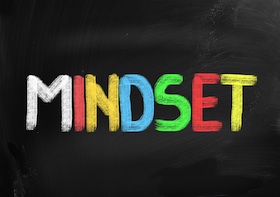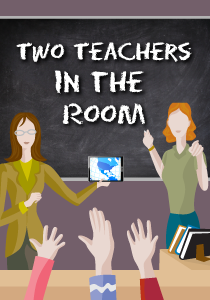Find Your Co-Teaching State of Mind
A MiddleWeb Blog
We’re two weeks into the New Year, and it’s safe to assume that most of us have made some resolutions and created some promises, because teachers are the kind of people who strive to become a better version of themselves.
Co-teachers are no different. Co-teachers create resolutions in hopes of improving planning, instruction and assessment (along with personal resolutions to exercise, eat better, and sleep more), so when we get to June, we can feel that sense of accomplishment for our students, for our colleagues, and for ourselves.
This all sounds great, but I am just not on board with this yearly resolution making process. Resolutions just create time-sensitive and unnecessary stress. Resolutions tend to be broken, forgotten, and often times rationalized away into the mix of busy schedules.
It’s About Setting Goals
I do believe in goal setting. I set goals on a daily, weekly and monthly basis. I am accustomed to pacing my progress toward achieving my personal and professional goals. So by the time the New Year comes around, I am relaxed and excited to reflect, renew, and rejuvenate. I am stress free because I paced myself every day–not just from January until about March when most resolutions are long forgotten.
For those people who do not forget, it’s often the case that they are riddled with guilt due to unmet resolutions. It’s just a waste of energy. For me, the ongoing goal setting process just makes more sense. I make sure my goals are manageable, well paced and realistic, and I revise them (guilt-free) as they evolve through my unfolding actions during daily routines and responsibilities.
This blog post is dedicated to all my co-teacher colleagues who are resolution makers. There is a way to make your co-teaching resolutions stick until they are met with success. It’s about finding the balance in your schedule, in your relationships with your co-teachers, and with yourself. It’s about establishing a co-teaching state of mind and staying in the flow all year round.
Tips to Help Develop a Co-Teaching State of Mind
 1. Begin with the end in mind
1. Begin with the end in mind
Backward planning is a surefire way to ensure that your daily lessons and units align with year-end goals. Create and monitor students’ goals frequently. Goals are derived from IEP goals, lesson objectives, Common Core and other curriculum expectations. Adjust the planning and delivery of instruction accordingly. Meet with your co-teacher as much as possible to plan. And if you do not have this planning time, find some sort of routine that works for your situation. (Are you having trouble thinking of ideas? Then share your thoughts in the comments section here, and we will seek solutions together!)
2. Embrace the Universal Design for Learning (UDL)
When you apply the powerful Universal Design for Learning, you will be making sure that your curriculum is accessible to all students. Plan to present your content through multiple means. Think about what the students will be doing as you guide their learning. Include a variety of visual and auditory presentations. Include a variety of ways students will express their understanding (include speaking, writing, creating, illustrating, etc.)
Finally, include multiple means of engaging your students. Provide choice, so students may take charge of their learning. Guide students to make personal connections and construct meaning in ways that help them retain concepts. UDL ensures that your teaching connects with students’ learning and personal achievement. When UDL is incorporated, students have many opportunities to think deeply and reinforce new information, so learning moves from short-term to long-term memory.
3. Make the Most of Collaboration
Regardless of your co-teaching relationship at this point in the year, make the most of it! Don’t get caught in a resigned, “whatever” mindset if your situation is less than desirable. Stand tall—speak up, and take action! Even if you are in a seemingly non-collaborative relationship, don’t let that stop you. Find a way to insert yourself into the instructional process. Check out this link for details about effective teaching in inclusion classes. Also, make sure to try at least one of these collaborative teaching styles at least once a month (and much more if you’re lucky!):
• Interactive Teaching: Two or more teachers shift roles between leading whole-class instruction, observing instruction and monitoring learning.
• Alternative Teaching: One teacher leads small-group instruction while the other teacher works with the rest of the class. This model works particularly well if a small group requires reinforcement or re-teaching to master a concept.
• Parallel Teaching: Two or more teachers lead small, mixed-ability groups of students in the same lesson. This approach functions well when teachers require a high level of focus and participation from students.
• Station Teaching: Two or more teachers lead or observe small groups of students as these groups rotate through several learning stations. This technique helps students stay on task as they complete shorter activities and transition clearly from task to task.
4. Keep Egos at Bay
One common way we break co-teaching resolutions comes about when one or more co-teachers allow egos to get in the way. Don’t do it! It’s pretty common that some teachers become territorial. It’s not easy to share a classroom—share students—and share instructional time. It’s not always easy to admit that your colleague has knowledge and expertise you can learn from. You can’t control your co-teacher’s ego, but you can control your own.
Do not take anything personally. When situations arise, handle them from the viewpoint that changing behavior is hard for students and adults. Be flexible. Consider the situation from the standpoint of others involved. Stay focused on the goals that are set for your students, and do your best to create a positive learning environment. Just make it happen—adjust your actions to find a way. Your students need you to do that.
It’s no secret
The secret to maintaining a co-teaching state of mind is in staying focused on your daily, weekly, and monthly goals. Stay true to your personal pedagogical beliefs. Share your voice as you listen to the voice of your colleagues. A co-teaching state of mind represents something much deeper than just “keeping your resolutions.” When you achieve this state, you will find yourself thinking more, saying more, and doing more to create positive learning environments.
So go to it! Go set those goals – and come share them here – let’s inspire one another! I am looking forward to the conversations….



































I like your article; however, I have one suggestion. When discussing Alternative Teaching there are so many other ways to use it other than as a remedial tool. When it’s only used for remediation, it really becomes obvious to the class which students seem to always be dependent on extra help and support.
The alternative group can also be used for enrichment, for a specialized task such as viewing items through a microscope or editing writing, as a quick pre-teaching group, or to catch up students that have been absent. These are some other ideas for using Alternative Teaching so that it never becomes “that group”.
Hi, Lisa, Great point! I find the alternate group works great in inclusion classrooms as long as we do not just pull specific students. In my English class, for example, I work with general and special education students on a one-to-one or small group basis when we are working on specific writing assignments.
All students have the opportunity to have this alternate time–in fact many gen. ed.students ask for this time–all students are invited. As you know, strategies that work well for special education students, work well for all students! Thanks so much for your thoughtful comment! You make such a valuable point–teachers must make sure that inclusion means inclusion for all!
You’re right Elizabeth, and I love the way you are using it in your classroom. I just wanted to make sure that your readers, that may be novices at co-teaching, saw many ways to use the alternative group and the skills of both teachers in the classroom. Thank you for you response and keep doing the great work you’re doing for all students!
Thank you, Lisa, for deepening the level of conversation and perspective here. Like all meaningful things, it is a work in progress for me. My focus is clear–even on those days when I am met with co-teaching obstacles. Some days are better than others. I just make sure that all of my steps are ultimately leading in the right direction! It is so inspiring and rejuvenating to connect with folks like you. Thanks so much!